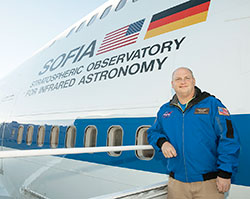Catholic Schools Week Supplement
Space flight helps educator lead students to a new dimension

Troy Cockrum poses for a photo near a NASA jetliner in November of 2015. The director of innovative teaching at St. Therese of the Infant Jesus (Little Flower) School in Indianapolis, Cockrum was one of 28 educators from across the country who was chosen to fly on NASA’s Stratospheric Observatory for Infrared Astronomy (SOFIA), the world’s largest flying telescope. (Submitted photo)
By John Shaughnessy
As the NASA jetliner climbed to 40,000 feet in the night sky, Troy Cockrum became mesmerized by the stunning sight that suddenly came into view.
Straight ahead, he could see the stars that formed the Big Dipper. And just to the right, the brilliant, breathtaking Northern Lights flickered and danced in the distance, leaving Cockrum in awe.
That moment also left the director of innovative teaching at St. Therese of the Infant Jesus (Little Flower) School in Indianapolis with one overriding wish.
“It was such an amazing experience that I wish every kid at our school could have seen it,” Cockrum says. “We’re in an environment here where not a lot of kids get to travel very far. I want them to realize they can have these experiences and go after them. I want them to see they have options available to them if they keep working on their education.”
Cockrum seized his opportunity when he was one of 28 educators from across the country in 2015 who was chosen to fly on NASA’s Stratospheric Observatory for Infrared Astronomy (SOFIA), the world’s largest flying telescope.
He spent four days in November at Edwards Air Force Base in southern California, getting an up-close view of NASA’s space-related missions.
“We made two flights, and each flight was about 10 hours,” Cockrum notes “We got up to about 45,000 feet. At 40,000 feet, they open the telescope and gather data. On our first flight, we saw nebula and proto stars. We were looking at how new stars were formed. We saw Neptune and Uranus on the second flight.
“It was interesting to see how they prepared for the flights. We sat through two mission briefings to see how they manage a meeting, and how everyone contributes to the mission. Just being in that environment at NASA, we saw the skills we want to teach students—problem-solving and collaboration.”
Cockrum is using the experience to inspire students at Little Flower, where he works with third- to eighth-graders on developing individual “expert projects.”
“I work with them on whatever they want to learn in a subject of their choosing. The goal is to have them get someone else excited about what they are doing.
“They were all excited about what I was doing. And it led to a lot of teaching moments. They asked me if I would be in zero gravity. It let me show them how gravity works. My experience also opened up a lot of dialogue about space. They asked me if I was scared. I said, ‘Of course, I’m scared, but this is a great opportunity.’ It’s great to talk to students about following your passions and finding opportunities to do this.”
He’s also using the experience to inspire teachers and develop new teaching strategies.
“Our middle school science teacher has been tying space into her lessons. We’re hoping to launch a near-space weather balloon in April.
“At NASA, everybody knew what the mission was, they understood the goals of the mission, and they knew how they were all going to contribute to the mission. One of my goals is to create more cross-curricular activities—finding opportunities for a science teacher and an English teacher to work together, or a math teacher and a social studies teacher to work together. Authentic learning is pulling in all these different content areas.”
Developing a mindset of lifelong learning for students and teachers is the driving mission for Cockrum, a former television producer and English teacher who is pursuing a doctoral degree in instructional systems technology.
“Lifelong learning has always been a part of what I do. I like to show kids that as well. We’re always learning, and we should always be open to learning. I tell our teachers, ‘We should be our best on the day we retire.’ We should always be striving to be better.”
Cockrum has learned that the best place for him to teach and continue learning is in a Catholic school.
“I’m familiar with the Catholic school environment,” says Cockrum, who spent his first 12 years of education in Catholic schools. “When I talk to colleagues in public schools, they have to deal with mandates from their school system. I just teach what’s best for my students. There’s also the autonomy Catholic schools have. We have the support of the archdiocese, but we operate independently.”
For Cockrum, there’s one more blessing of teaching in a Catholic school.
“It’s great to openly live your faith without worrying about losing your job.” †
